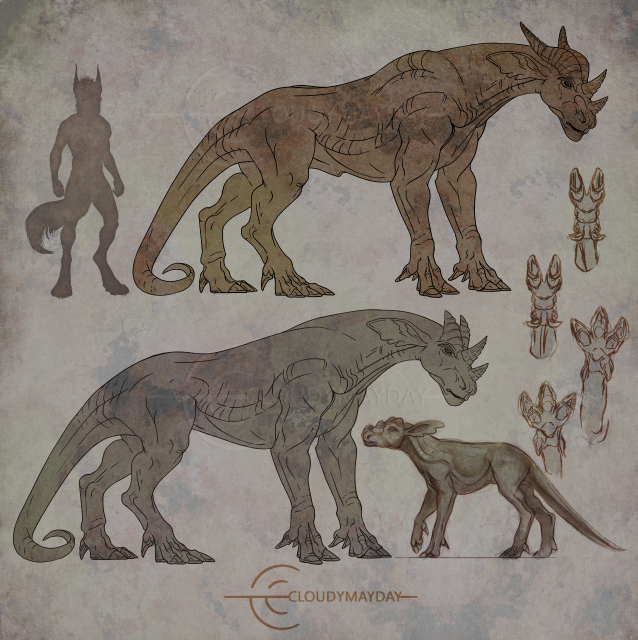Tǎrtaŋk
(tahr-tængk - roll the 'r')
If there is one animal that stands at the center of Sērbaka culture and civilization, it would have to be the tǎrtaŋk. Tǎrtaŋk are potentially dangerous animals, though domestication has reduced much of the risk, as has increased knowledge, and understanding of tǎrtaŋk behavior. These large animals are primarily breed for the meat, yet all the animal is used; pelts become walls of temporary buildings, or in decorations for modern interiors, often including paintings or pictograms, many representing family history, or events personal to the individual commissioning such a work. Nothing goes to waste.
Some animals are kept for several years serving as draft and pack animals, the primary courier transport to and from isolated communities in challenging environments, typically based at a central distribution hub of sorts. Even in these instances, older, still healthy animals may be exchanged for younger more virulent animals, the old animals going to slaughter.
Basic Information
Tǎrtaŋk are large quadrupedal four-toed ungulate (hoofed) mammalian-like animals. Males, females, and infants present horns, though adult male horns are potentially the most lethal, but all should be considered dangerous. All walk on two toes on the front legs and three on the rear, however, two modified toes on the front legs, and one on the rear legs, act as spurs, which can be lethal even if the animal misses trampling upon its target. Most herds have been carefully bred and selected for a generally more docile attitude, but some wild herds have had individuals with more temperamental personalities introduced as a means to make them a more rewarding hunt; hunting from among these wild herds is often used as a right of passage for many young Sērbaka.
Additional Information
Archeological evidence suggests the first domestication even was a line of Tǎrtaŋk, first occurring some twenty-five thousand years ago. Two more recent domestication events, one around eighteen thousand years ago, and another eleven thousand years ago, both from original wild herds of tǎrtaŋk, resulting in three distinct breeding lines, though overlap in intervening years has reintroduced genetic diversity throughout all resident tǎrtaŋk.
Lifespan
Natural: 30 to 38 years
(20 to 25 Earth years)Food Stock: 3 to 5 years
(2 to 3 Earth years)Breeding: 7 to 18 years
(4.5 to 12 Earth years)shorter for male; longer for female
Average Height
Measured at the shoulders
Male: 298 to 316 cm (9 ft. 9 in. to 10 ft. 4.5 in.)
Female: 247 to 273 cm (8 ft. 1 in. to 8 ft. 11 in.)
Average Weight
Male: 3.56 to 4.68 tonnes (3.9 to 5.15 tons)
Female: 2.34 to 3.15 tonnes (2.58 to 3.47 tons)
Entry for Worldbuilding Summer Camp 2021
Answering: "
a species of working animal"
Copyright (c) 2021 Wolff Chaffee - All rights reserved
Cover image:
by
World Anvil




Comments